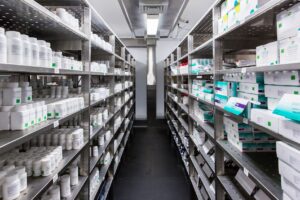Pharmaceuticals
Spotlight on stability: API and drug product testing 8th April 2021
By Anna Cousens, Business Development Manager, Almac Sciences
Stability studies are key to drug development. An integral part of any New Drug Application (NDA) is to perform stability studies on active pharmaceutical ingredients (APIs) and drug products to assess degradation and inform shelf-life prior to market release. For some programmes, further investigation is required to demonstrate stability of key raw materials, intermediates or excipients used in the manufacturing process. Anna Cousens, Business Development Manager at Almac Sciences, describes what studies need to be performed, and how, to ensure best product performance.
Developing a drug is a long and complex process, and the stability requirements change depending on the phase of development. At the early stage, little is known about the API and formulation, so this work is required to inform on the degradation profile of the compound. It is critical to know how the API degrades over time; if it is particularly sensitive to light, heat or humidity,and how best to store it to ensure that when it finally reaches a patient it is of the required quality and purity. When formulating a drug, studies must be conducted to demonstrate interactions between the API and any excipients used, and to confirm that these do not accelerate the degradation of the active ingredient. Once the final product is packaged, stability studies must also be undertaken to confirm that the finished product remains intact, and that the packaging selected is fit for purpose.
 During the early stages of clinical development, every new batch of API or drug product should be placed on stability, and each new packaging presentation will also require supporting stability data. Once stability data has been generated it may not be necessary to place every new manufacture on stability provided that there is reasonable coverage from existing studies.
During the early stages of clinical development, every new batch of API or drug product should be placed on stability, and each new packaging presentation will also require supporting stability data. Once stability data has been generated it may not be necessary to place every new manufacture on stability provided that there is reasonable coverage from existing studies.
When performing stability studies there is much to consider:
- Analytical methods
- Batches required to be set down
- Conditions
- Analysis required at each timepoint
- Transport studies
- In-use stability
- Reference standards
Analytical methods
When conducting stability testing it is imperative that the analytical methods used are fit for purpose. Without a good understanding of the analytical testing, stability studies would be pointless, as the methods need to be able to detect any degradation in the product. For GMP stability programs validated analytical methods are required. As an example, Almac were provided with some client methods but were required to perform full ICH validation of the HPLC method. This was required for both the API and drug product, and because the methods were similar for both, we found efficiencies in the project by conducting these two validations in parallel. Many outsourcing partners routinely perform ICH validations for methods developed in their own labs, or at client or third-party labs.
 When releasing a batch of API or drug product, a specification describing the full scope of testing is required. Often when setting down batches on stability, this release testing will be leveraged by the stability group. In some circumstances it is possible to leverage the release testing results for the T = 0 timepoint. This can save time and money by not duplicating these results.
When releasing a batch of API or drug product, a specification describing the full scope of testing is required. Often when setting down batches on stability, this release testing will be leveraged by the stability group. In some circumstances it is possible to leverage the release testing results for the T = 0 timepoint. This can save time and money by not duplicating these results.
However, using release data for T = 0 is not always practical, and repeating this testing can add value to a project. In some instances, the stability partner will be setting down stability on products that are not manufactured on site and will have no previous experience of the analytical methods. For a GMP stability study, these methods will require validation prior to use. The inclusion of T = 0 testing of these batches can be used to perform a limited validation of the required methods by comparison of data with the releasing lab. This is a convenient and efficient way of bringing fully validated methods into the partnering company.
Batches to be set down
As the drug proceeds through early clinical trials and moves towards commercialization, there may be multiple presentations to consider. A typical example of such presentations includes:
- Active ingredient (API) – 3 batches
- Drug product formulation (capsules) – 3 batches
- Drug packaging (capsules in blister) – 3 batches
- Drug packaging (capsules in bottle) – 3 batches
It is imperative that the stability team fully understands when samples need to be pulled. The project can be made more efficient by pulling stability timepoints together, reducing the time required to set up analytical equipment. However, there are standard requirements around the window for testing to be performed at each timepoint, so the length of the testing runs must be considered and samples pulled in line with the testing regimen. A dedicated stability team with sufficient equipment to prevent bottlenecks when large studies require significant sample numbers at a specific timepoint is hugely beneficial.
Test conditions
Table 1 highlights standard ICH conditions within stability chambers. Whilst there is often commonality, the conditions required are informed by the nature of the compound. For example, it is more likely that peptides, proteins and biologics will be stored at cold or frozen conditions due to their instability, and early-phase small-molecule studies typically follow a standard approach(Table 2). Results from this early data will inform later-phase studies.
Table 1: ICH stability conditions.
| -20˚C, 2-8C | 30˚C/65%RH |
| 25˚C/60%RH | 30˚C/75%RH |
| 40˚C/75%RH | Photo stability |
Table 2. A typical stability schedule.
| Condition | Time point (months) | ||||||||
| 0 | 1 | 3 | 6 | 9 | 12 | 18 | 24 | 36 | |
| 2ºC – 8ºC | X | O | O | O | O | O | O | O | O |
| 25ºC/60% RH | X | X | X | X | X | X | X | X | |
| 40ºC/75% RH | X | X | X | ||||||
| X = Scheduled testing, O = Optional testing on request | |||||||||
Figure 2: a typical stability schedule for small molecules
Analysis at each timepointA typical study runs between 3 and 5 years, and whilst these studies are used to obtain long-term shelf-life data, at early stages products will be exposed to harsher conditions – higher temperature, increased relative humidity – to stress them and increase the rate of degradation. This is important, as it provides an overall idea of the degradation profile of the compound and potentially highlights issues with analytical methods or the rise in level of certain impurities. Accelerated conditions can also be important when considering the infrastructure of the end user market. They can also be used to predict the shelf life of API or drug product in line with ICH guidelines.
A limited testing schedule will be performed at each timepoint, and typical testing requires a purity method (likely by HPLC) that has been proven to be stability indicating. XRPD analysis can be included to demonstrate there has been no change in physical form, and a Karl Fisher technique is included to show the presence of moisture and indicate if the drug is hygroscopic. Microbiological testing can be included at some (but not necessarily all) timepoints to prove the absence of microbial contamination. For finished products, dissolution testing will be included to simulate the effectiveness of the drug in vivo.
Transport /temperature cycling studies
Stability studies indicate degradation of products under fixed conditions, but in the real world it can be difficult to maintain these conditions when distributing worldwide. Logistically, planes can be delayed, trucks can be stopped at customs, or stuck in a long tailback on the motorway.
To ensure that temperature excursions do not lead to wasted product, it is possible to conduct a transport study. This is where the drug is exposed to temperature cycling to mimic freezing and thawing of the drug. Typically, a drug will be exposed in its final packaged form to 3 cycles ranging from -20C to 40C/75% RH over 2 weeks, then set down onto a formal stability study for 36 months.This temperature cycling is performed prior to the set down of the main stability study, allowing the increase of efficiency by pulling these time points in parallel.
In-use stability
Depending on the dose regimen, in-use stability may be required. For tablets / capsules that are blisterpacked, each dose will remain sealed until point of use. For bottled tablets and products, as each dose is taken out, the remaining tablets will be exposed to the elements as the bottle is opened. For example, if the dosage is 2 tablets daily for 6 weeks, the final 2 tablets will have been exposed to changes in humidity, temperature and light daily for 42 days prior to ingestion. In-use stability studies have been designed to mimic this exposure, with bottles opened in controlled conditions of 25°C/60% RH conditions for 20 minutes each day, with 2 tablets removed at each timepoint. It is not necessary to perform the analysis on this daily, only on the final tablets to ensure that the final dose is fit for purpose.
Reference standards
Most stability studies will include purity/assay by HPLC as part of their testing regime. These methods will require the use of a reference standard – a highly purified and fully characterized sample of the API or impurity. These standards are typically small quantities stored in vials with a need for recertification, most likely on an annual basis. Over a 5 year stability study it is probable that standards will need recertification multiple times. Over a prolonged period of time it is possible that reference standards can become depleted and an in-house strong synthetic chemistry group that can assist with remanufacture of reference standards is beneficial. This could be performed via chromatographic purification of API samples, extraction of/by degradation products from manufacturing mother liquors, or total synthesis.
In conclusion
There is much to consider when addressing stability studies. Typical conversations include capacity, and the conditions available, but as discussed there are a wider number of factors to consider. It is therefore critical when partnering to consider lab footprint, experience and supporting capabilities to ensure your product is in the safest hands.
Almac have significant expertise in stability studies; its team has over 20 years’ experience, with 350 studies currently active. Across the company’s three global sites, it sets down 60-70 studies each year covering small molecules, peptides, biologics, active ingredients, tablets, capsules, vials, blisters, bottles and devices. Each month Almac’s dedicated team processes 30 pull points, each of which includes sampling, analysis, QA review and reporting, making the company a leading global partner for stability studies.


